
January 2017 (Volume 26, Number 1)
Gallery of Fluid Motion Winners from the 2016 APS Division of Fluid Dynamics Meeting
By Rachel Gaal
Every year, the APS Division of Fluid Dynamics hosts the Gallery of Fluid Motion at its annual meeting with the aim of highlighting the art and science of fluid mechanics. In 2016, dozens of poster presentations were submitted to the gallery. Of those, a selection are chosen as Gallery Winners, or Milton van Dyke Awardees. The Milton van Dyke award is named after Milton van Dyke of Stanford University, who was the founding co-editor of Annual Review of Fluid Mechanics and the compiler and publisher of An Album of Fluid Motion in 1982. The winning entries will be published in Physical Review Fluids, published by APS. For more on all of the entries and winners, visit gfm.aps.org
Videos
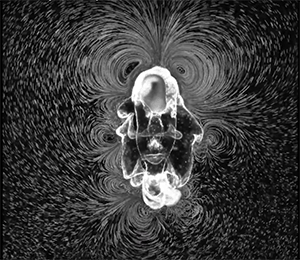
V0055: Eat, Prey, Swim: Dynamic vortex arrays created by starfish larvae — Milton van Dyke Award — William Gilpin, Vivek N. Prakash, Manu Prakash (Stanford University)
Before forming their long and wavy arms, starfish are micro-sized larvae swimming through the ocean by means of tiny, hairlike cilia that cover their bodies. To learn more about how these newborns maneuver and feed in open waters, researchers from Stanford University trapped a single larva under a microscope slide and filmed the flow patterns generated by the cilia movement. To better observe details of the flow field, the team added tiny plastic beads to the surrounding fluid that revealed small vortices in time-lapse recordings. A closer look revealed that areas of oppositely flapping cilia (known as reversal regions) generated small vortices, which helped draw in larger amounts of algae from farther away. While this movement helped increase the feeding rate, the large number of vortices resulted in slower swimming through the viscous fluid. The team observed that the larvae could "change gears" with cilia motion, increasing their swimming speed to evade looming predators.
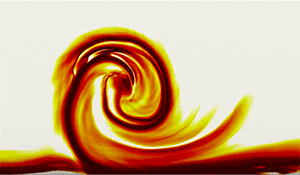
V0076: Sweeping Jet from a Fluidic Oscillator in Crossflow — Milton van Dyke Award — Florian Ostermann, Philipp Godbersen, Rene Woszidlo, C. Navid Nayeri, C. Oliver Paschereit (Hermann-Föttinger-Institut, Technische Universität Berlin, Berlin, Germany)
With help from particle imaging, a team of researchers from Berlin was able to capture an array of 3D flow features of spatially oscillating jets. A sweeping jet, created by a fluidic oscillator, was emitted into a strong cross flow generated by a wind tunnel. A particle imaging velocimetry (PIV) system, which moved transverse to the crossflow, was able to combine footage of the sweeping jet in all three dimensions, revealing crucial information about the streak volume and velocity of particles originating from the sweeping jet. Slowed down to 250 times the original speed, the team observed two alternating streamwise vortices, which deflected the airflow between the vortices downward. This process, dubbed ‘downwash’, may be one of the driving factors behind the effective use of sweeping jets in separation control of fluid flows.

V0095: The shear joy of watching paint dry — Milton van Dyke Award — Randy Hurd, Nathan Speirs (Utah State University); Jesse Belden (Naval Undersea Warfare Center); Zhao Pan, Ben Lovett, Wesley Robinson (Utah State University); Madison Boyer (Brigham Young University); Saberul Sharker, Mohammad Mansoor, Tadd Truscott, Andrew Merritt (Utah State University)
Known for his "pour paintings," artist Holton Rower pours gallons of rainbow-colored paint over block towers, and waits for the streams of paint to pool onto the canvas below. Researchers from the Splash Lab at Utah State University and colleagues from the Naval Undersea Warfare Center and Brigham Young University filmed their own recreations of Rower’s pour paintings, and identified the subtle fluid dynamics behind these works of art. When poured on top of a block tower, the paint slowly spread to the edges and created flow channels that dripped down the edges of the block. Depending on the height of the block, the pattern of the pooling paint below was either symmetrical or non-uniform in relation to the top pattern. The complex patterns associated with taller towers were caused by the paint transitioning from a thin film flow into a narrow jet. Viscous buckling and turbulent flow linked with this transition caused zig zags and discontinuities to emerge in the pour patterns, connecting the surreal patterns of Rower’s paintings with dynamics of paint flow.

V0038: Fall and fragmentation of liquid metal in a viscous fluid — GFM Award Winner — Jean Baptiste Wacheul, Michaël Le Bars (CNRS, Aix-Marseille Univ and ECM, UMR 7342)
Earth may have taken some heavy beatings in the early stages of its existence. But unlike the Earth we know today, our planet of long ago lacked the hard outer crust to protect its iron core-- and was, instead, covered in a hot, magma ocean of liquid silicate. Many theories speculate that collisions between Earth and other terrestrial planets would send fragments of the planet’s liquid iron core flying through the molten silicate, where radioactive elements were exchanged. A group of researchers from the French National Center for Scientific Research (CNRS) set up a laboratory analog to mimic these post-impact flows, using a tank filled with a water-glycerol mixture, and a balloon filled with liquid gallium. The metal-filled balloon was suspended within the viscous fluid, then carefully popped, to observe the amount of fragmentation while traveling through the oil-water mixture. The film recordings, slowed down by a factor of 10, show the complex dynamics of the moving cloud of liquid metal drops, and the effects of the viscosity ratio between iron and silicate on the amount of liquid metal fragmentation. A larger ambient fluid viscosity resulted in a faster descent, but less fragmentation of liquid metal. A larger gallium viscosity descended slower, but generated larger and stabilized drops of metal during fragmentation.

V0046: Flight of a falling maple seed — GFM Award Winner — Injae Lee, Haecheon Choi (Seoul National University)
The maple tree often uses a special pollinating trick; each of its seeds is equipped with a small wing, so that these offspring spiral down from the tree tops, and are picked up by the wind to eventually scatter towards faraway soils. These falling maple seeds were studied by a group of researchers from Seoul National University to better understand the "autorotation" mechanism that each seed exhibits. The team used a 3D scanner to calculate the seed’s center of mass, then numerically simulated the rate of rotation, velocity speed, and dispersion of the falling seed in both quiescent and windy conditions. In calm weather, the seed started off falling with no spin, and then entered a steady, circular rotation, which significantly decreased the descending velocity. The rotation and falling velocity then decreased to a periodic rotation rate, which created an elegant flow pattern from the drag of the wing flowing through air. Windy conditions showed the same characteristics of velocity and rotation while falling, but the seed was carried farther out in the direction of wind flow due to low descending velocity.
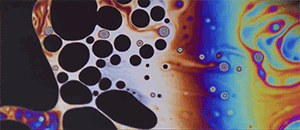
V0092: Before the bubble ruptures — GFM Award Winner — Li Shen, Fabian Denner (Imperial College London); Neal Morgan (Shell Solutions UK); Berend van Wachem, Daniele Dini (Imperial College London)
Although bubbles appear everywhere in daily life, scientists still don’t fully understand the process of bubble-popping and what happens just before they rupture. Researchers from Imperial College London and Shell Solutions UK set out to observe the behavior of convex and concave bubbles created from dishwashing liquid, one minute before their rupture. The video footage recorded of concave bubbles showed a colorful and dark portion of the film, where the brighter colors corresponded to thicker soap film and gravity-driven flow. Small secluded dots began to form by means of diffusion on the darker, thinner film over time, then started to rapidly converge. This created a convective environment which coarsened the film altogether—creating irregular patterns until the bubble’s eventual rupture. While viewing the convex bubble directly overhead, small white dots formed a spatially non-uniform pattern that did not exhibit the same coarsening effects as the concave bubble film, but the pattern spread outward until the eventual pop. Even though the dynamics are subtly different for each system, these thin soap bubbles can act in mysterious ways when observed up-close.
Posters

P0020: Formation of mini vortex rings arising from a vortex pair impinging on a wavy wall — Milton van Dyke Award — Sarah Morris, C.H.K. Williamson (Cornell University)
In a typical laboratory setting, researchers send wavy vortex pairs onto a flat wall to study specific flow features and turbulence of these structures. A group from Cornell University decided to switch things around, and instead experiment with straight vortices encountering a wavy wall. The observations reveal critical features of this unique flow, showing the formation of mini vortex rings that do not form in typical experiments. Using two long, computer controlled flaps in a water tank, the team generated a counter-rotating vortex pair that travelled downward toward an acrylic-casted hillock (which looks like a continuous platform of small hills). Using fluorescein dye and laser light, the initial vortex pair was illuminated as it descended toward the hillocks. High-definition imaging captured the first interaction and the subsequent stages, leading to the formation of mini vortex rings in the longitudinal plane. Notable features that were discovered in this particular flow included a triggered vorticity cancellation above the "hill" regions of the wavy wall, and strong axial flow that formed subsequently in the valley regions. This contrast of rotational speed led to the formation of the vortex rings within the valleys and the "rebounding" of these rings with the primary vortices.
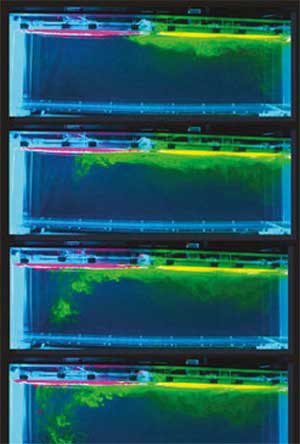
P0028: Turbulent Horizontal Convection at High Prandtl Numbers — Milton van Dyke Award — Pierre-Yves Passaggia, Matthew Hurley, Brian White, Alberto Scotti (Department of Marine Sciences, University of North Carolina, Chapel Hill, NC)
When freshwater and saltwater meet, circulations called "horizontal convection" churn the two bodies of water together. Researchers from University of North Carolina, Chapel HIll, simulated this mixing in a laboratory setting, to better understand the flow properties and energetics of horizontal convection in water with high amounts of kinematic viscosity (high Prandtl numbers). The team dyed the saltwater with rhodamine, and the fresh water with fluorescein, and sectioned the water types along the surface of tank fluid. The dyes illuminated the laminar movement of freshwater toward the salt water, which then sank toward the bottom of the tank in a turbulent plume. The eventual upwelling of the fluorescein plume showed that a steady convective current was mixing these two fluids together, but it was unclear if the illuminated plume consisted of only fresh or salt-water. To better identify areas in the tank that had partially homogeneous areas of mixed fluid, the group used a technique called dual emission laser-induced fluorescence (DELIF). The resulting image revealed higher compositions of salt in the downdrafts of the plume, which further supported overturning circulation in the tank fluid.

P0030: Progressive Monte-Carlo Rendering of Atmospheric Flow Features Across Scales — Milton van Dyke Award — Tobias Günther (ETH Zurich, Switzerland); Alexander Kuhn, Hans-Christian Hege (Zuse Institute Berlin, Germany); Markus Gross (ETH Zurich, Switzerland); Holger Theisel (University of Magdeburg, Germany)
With the help of a powerful statistical computer modeling technique known as "Monte-Carlo rendering", researchers from ETH Zurich, the Zuse Institute, and the University of Magdeburg generated highly detailed simulations of the Earth’s atmospheric flow patterns across a wide range of scales. Using climate data from the European Centre for Medium-Range Weather Forecasts (ECMWF), the team created a 10,000 km scale (global scale) graphic that depicted spatial turbulent structures of cyclones, large flow patterns, and other turbulent activity. Many meteorological phenomenon, like thunderstorm development and topographic influence on flow, happen at smaller scales, so the team used model data from the COSMO-DE model (Germany’s operational weather model), to render images on 1,000 km scale (synoptic scale), 100 km scale (mesoscale), and 10 km scale over parts of Germany. These high resolution images uncover structural differences and patterns of airflow at the small scale that typically are hidden by larger weather prediction models during simulation. By using Monte-Carlo rendering, the graphics also reveal long-term flow structures that take longer time scales (days) to occur.
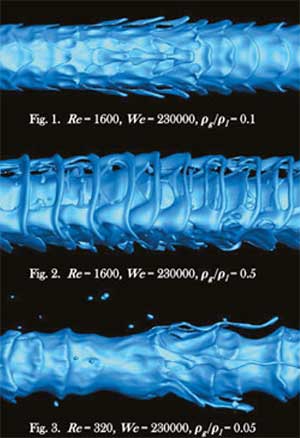
P0009: Computational Simulation of Liquid Jet Atomization — GFM Award Winner — Dorrin Jarrahbashi (Georgia Institute of Technology); William Sirignano, Pavel Popov (University of California, Irvine); Fazle Hussain (Texas Tech University)
Atomizers, found in hairspray bottles and vaporizers, help break up liquids into finer sprays. To understand the complexities of liquid atomization, researchers from the Georgia Institute of Technology, the University of California Irvine, and Texas Tech University, joined forces to numerically simulate the breakup of a liquid jet surrounded by a high-density, coaxial gas flow. They observed three different types of liquid disintegration, depending on the density ratio between the gas and liquid, and the values of fluid flow parameters (including Reynolds and Weber numbers). Higher gas densities revealed ordered lobe formations that are described as "liquid bridges," which connected the uniform folds of the liquid jet through a bridge-like structure and symmetrical holes. When the liquid jet flow was more turbulent (higher Reynolds and Weber values), ligaments and then small droplets developed following hole and liquid bridge formations. With less turbulent flow and lower gas densities, there were no holes or liquid bridges, but more ligaments that formed from irregular wrinkles and folds within the jet.

P0012: Large-eddy simulation of a stratocumulus cloud — GFM Award Winner — Georgios Matheou (Jet Propulsion Laboratory, California Institute of Technology); Daniel Chung (University of Melbourne, Australia); Joao Teixeira (Jet Propulsion Laboratory, California Institute of Technology)
Try taking a butter knife to a cloud, and splitting it into horizontal and vertical layers. Although this seems like a trick question, researchers at NASA-JPL did just that in numerical simulations. Each layer of their numerically-simulated stratocumulus cloud (a type of cloud that acts like a blanket in the lower portions of the Earth’s atmosphere) told a different story of the cloud’s development, and what kind of driving force takes place in different boundaries of the atmosphere. The horizontal layers near the surface show turbulent, shear-driven streaks aligned in the direction of the mean wind flow. Moving up into the middle of the cloud layer, more buoyancy-driven convection reveals itself with cellular-like structure, that is characteristic of the iconic cumulus cloud. The highest horizontal layer, near the boundary layer of the atmosphere, depicts cauliflower-like cloud tops. This boundary, which acts like a cap on the maximum turbulent convection, is typically the area where incoming solar radiation is reflected or absorbed, which is key to the Earth’s energy exchange budget.
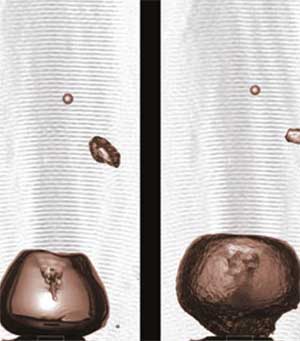
P0044: Accelerated Condensation in an Ultrasonic Field — GFM Award Winner — Thomas Boziuk, Marc Smith, Ari Glezer (Georgia Institute of Technology)
When a vapor is injected into a pool of liquid, tiny bubbles form and float upwards, unless they pop before reaching the surface. The demise of a vapor bubble usually begins with a liquid spear that penetrates the bottom of the bubble. These spears happen to be self-inflicted wounds, the result of the pinch-off of an individual bubble from the large stream jet of vapor. This process is a natural part of vapor bubble condensation, but researchers from the Georgia Institute of Technology decided to speed up the process using acoustic effects. Just before pinch-off, the team subjected the bubble to an acoustic beam that increased the pressure on top of the vapor stream, and forced the bubble to implode on itself from the top, which propelled a similar liquid spear into the bubble. This process accelerated the bubble collapse, and revealed the effect of acoustics on liquid-vapor interactions.
©1995 - 2024, AMERICAN PHYSICAL SOCIETY
APS encourages the redistribution of the materials included in this newspaper provided that attribution to the source is noted and the materials are not truncated or changed.
Editor: David Voss
Staff Science Writer: Rachel Gaal
Contributing Correspondent: Alaina G. Levine
Publication Designer and Production: Nancy Bennett-Karasik
